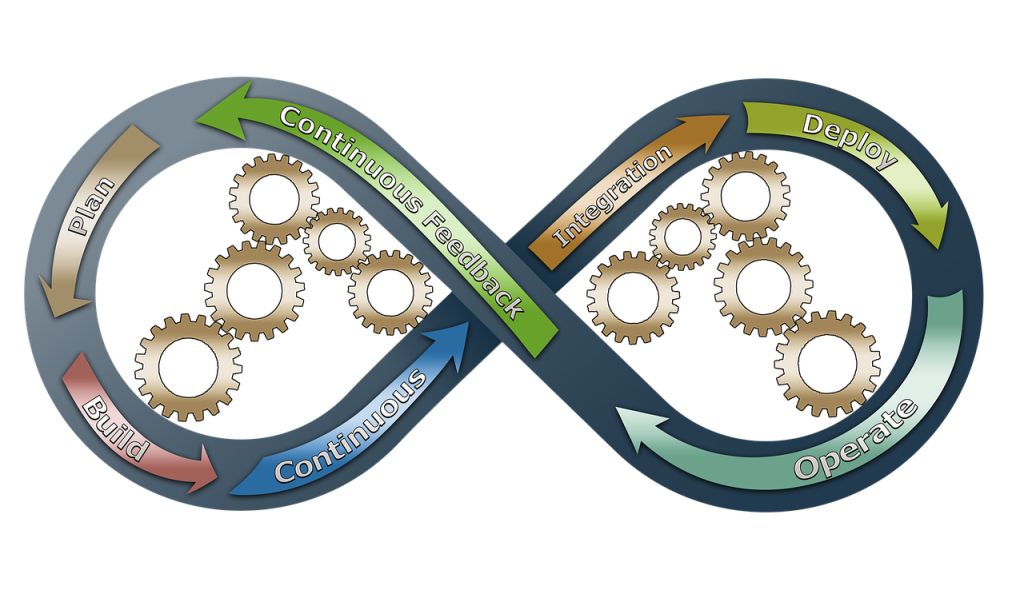
DevOps philosophy may be a difficult concept to wrap your mind around if you’re entirely new to the software industry or have had practically no experience in technical roles. But for your business, it is imperative to understand what it is and how it originated, and most importantly, how it helps your business. In this article, we will discuss all these.
Table of Contents
What Is DevOps?
Patrick Debois, an independent IT consultant, coined the term DevOps around a decade ago. DevOps is a clipped compound word for Development & Operation.
Before understanding what DevOps is, we must know what DevOps is not.DevOps is not a tool, not a programming language, and not even a technology.
Then, what is DevOps? DevOps is a philosophy, a mindset. It is one of the guiding principles using which you can take your product to the end-user. It’s one of the working strategies for moving items from development to production, and it’s a concept in application lifecycle management (ALM). It reduces the gap between development and operations, making all of their jobs easier.
What Does the Infinite Loop of DevOps Symbolize?

The infinity sign in the DevOps symbolizes the continuous process of improving efficiency and constant engagement of the teams. The DevOps approach makes companies adapt faster to updates and development changes. With DevOps, the teams can now deliver quickly, and the deployments are more consistent and smooth.
Although DevOps is not a tool itself, organizations use a variety of tools to implement DevOps philosophy in multiple phases. Let’s see what these phases are alongwith their tools.
- Planning Phase: Development team lays out a strategy that is based on the application goals. Following the creation of the plan, the coding process begins.
- Coding Phase: Development team works on the code or separate versions of the same code. These codes get stored in a repository using version control tools like Git. Version control software tools document changes to files by keeping track of modifications done to the code.
- Building Phase: Build software are programs that simplify the process of turning source code into executable applications (e.g., .apk for an Android app). They compile, link, and package the code into a usable or executable form. Maven and Gradleare some tools used in build automation.
- Testing Phase: DevOps emphasizes testing automation to test the code for bugs and errors. After the code building, testing automation tools like Selenium examine them. The QA team also does some manual testing.
The development team can declare the code ready for deployment and send it to the operations team after it has passed multiple manual and automated tests.
- Deployment Phase: The code is now being deployed in the working environment by the operations team. Docker, Ansible, and Kubernetes are the most popular tools for automating these phases.
- Monitoring Phase: The operations team keeps an eye on the product after it gets deployed. One of the best methods for automating this process is Nagios. After this phase, the feedback obtained is sent back into the planning phase.
- Integration Phase: The heart of the DevOps life cycle, the knot in the infinity loop, is the constant feedback mechanism from monitoring to planning phases. The knot is the integration stage.
Back to the planning phase, where the development team takes the call based on the feedback, and sets requirements for further development.
If the new code passes the tests, it gets deployed, and the cycle begins again. This process is called continuous integration. Jenkins is the most prominent open-source continuousintegration tool used to send the code for building and testing.
The History of DevOps – Why Was It Required?
Usually, in a software product development company, there are two teams:
Team Development writes codes (on platforms like React, Node, Java, etc.) for new products, novel features, security updates and bug fixes, design features, and tests.
Team Operations manages server configurations, scalability (based on the traffic, making decisions on local resources or cloud services requirements), bandwidth, security, and backups.
Teams Were Working in Silos
In a traditional mindset, the development team would figuratively throw the code over the wall to the operations. The planning and execution of the work of the development and operations teams were virtually invisible to each other.
If dev and ops are sitting in silos, then both are oblivious of each other’s work. They have no idea what’s going on on the other side of the wall. So, in big applications especially, the development team keeps doing updates and dump them to the operations team. However, the operations team is too busy monitoring, scaling, and security tasks, and they can schedule to release these updates only once or twice a month.
Lack of Coordination Resulted in Loss in Business
Due to the lack of collaboration between the teams, there were delays in releasing those updates to the end-users. This delay resulted in getting beaten by the competition who releases products and updates faster than you.
The Challenges That the Dev Side Was Facing
The delay in releasing updates and getting feedback on the same also made it difficult for the development team to manage both the pending code and the next feature or software.
Development team might also face unexpected issues or difficulties when the code gets eventually deployed into the production environment. It usually happens because the developer primarily develops the code for the development environment, which is not identical to the production environment.
The Challenges That the Ops Side Was Facing
The operations team had its challenges too. System Administrator (SysAdmin) from the operations team is responsible for maintaining and ensuring the uptime of the production environment. With the launch of new products and consumers using more of their services, the number of servers they needed to manage was continually increasing.
The job of SysAdmins became more challenging than ever. The tools they were using to administer the servers were no longer efficient to manage an enormously large volume of servers. This problem also had an impact on how the new codes were getting deployed in the live environment.
Usually, when a new code used to be released, it took a little tweaking to fit into the production environment. It is why SysAdmins are required to schedule code deployments and only used to do it once or twice a month in traditional methodology. Once a new code finally gets deployed, it’s the operation’s responsibility to diagnose any errors or problems caused by the changes.
Thus, both development and operations had their challenges, which were getting more difficult due to lack of coordination and awareness about each other’s job.
The Solution: DevOps
At the core, both development and operations have the same goal, which is the success of their product and the satisfaction of the end users.
The DevOps philosophy solves these issues by bringing the development, testing, and operations teams together. They all sit down together, discuss everything side by side, and even share roles and responsibilities occasionally to ensure that everyone is on the same page throughout the application lifecycle.
In short, DevOps Mindset helps the team to:
- Work Together and think more alike
- Break silos and share responsibilities.
DevOps & Automation
DevOps also places a strong emphasis on automation. The more tasks are automated, the more time a person has to collaborate, develop, and evaluate to meet consumer expectations.
Following DevOps philosophy, companies automate their:
- Testing
- Workflows
- Infrastructure
In the previous section, we have discussed how during each phase of DevOps infinity loop, there are tools that streamline and automate the tasks.
DevOps: A Step-Up from Agile
In DevOps, the developers write software in small chunks that get integrated, tested, monitored, and deployed many times a day. It is much more efficient and productive than the traditional way of writing large chunks of software over weeks or months and then doing weeks or months of testing. Additionally, now we have identical development and production environments based on the same configuration.
Writing small chunks of software will allow companies to:
- Increase the frequency of the deployment.
- Adopt an iterative approach of continuously monitoring, measuring, and improving the code and operations.
- Enhance their ability to respond to market needs and other variables that can impact the software.
According to the DevOps mindset, rather than building and configuring software and infrastructure on an ad hoc basis, the development and operations teams would create configuration management code that outlines how they should be built. As a result, they’ll be able to extend their infrastructure to dozens, hundreds, or even thousands of servers across many regions and hardware variants.
Another change a DevOps-oriented team would adopt is to use a source control system to track and record any changes to the application and configuration management code.
The most significant shift that the development and operations teams would make is to embrace a discipline of near-real-time application performance monitoring and optimization. It will help developers understand how their modifications will affect performance. The ultimate objective is to build a production environment that provides a positive experience for its consumers.
Thus, we see that DevOps is sort of like an agile methodology that has looped in operations in its equation.
What Benefit Does a DevOps-Oriented Team Give to a Company?
DevOps helps firms focus on more business-centric duties, such as improving online content and customer service, by automating infrastructure. They’ll devote more time to these activities that benefit their companies.
When a business can build and offer better products, they have happier customers and happier developers. So, customer and employee retention increases meaning more productivity and cost-effectiveness, and enhanced profits.
Way Forward
According to the report by Grand View Research, Inc., the worldwide DevOps industry is estimated to reach USD 12.85 billion by 2025. As per their analysis, increased digitization of businesses to automate business operations, rising implementation of cloud technologies, soaring adoption of agile frameworks, and the need for improved communication between IT teams to improve operational efficiency will all drive this market growth.
But merely adopting the tools, like Jenkins, and doing superficial changes into your working methodology will not help your business to get all benefits of adopting DevOps. Companies who have progressed beyond a mediocre DevOps adoption appear to have one trait: more significant structural changes.
Alternatively, you can opt to outsource your DevOps process toDevOps Services, a technology partner who can take care of the infrastructure and processes for you. In the meanwhile, your company can concentrate on its business and marketing objectives.

I am Bhupendra Prajapat, working as a Digital Marketing Specialist at Advantal Technologies. Advantal Technologies is a leading IT and software development company working with clients from various business verticals. We work on cutting-edge technologies, including mobile app development, IoT, Blockchain, and AI.